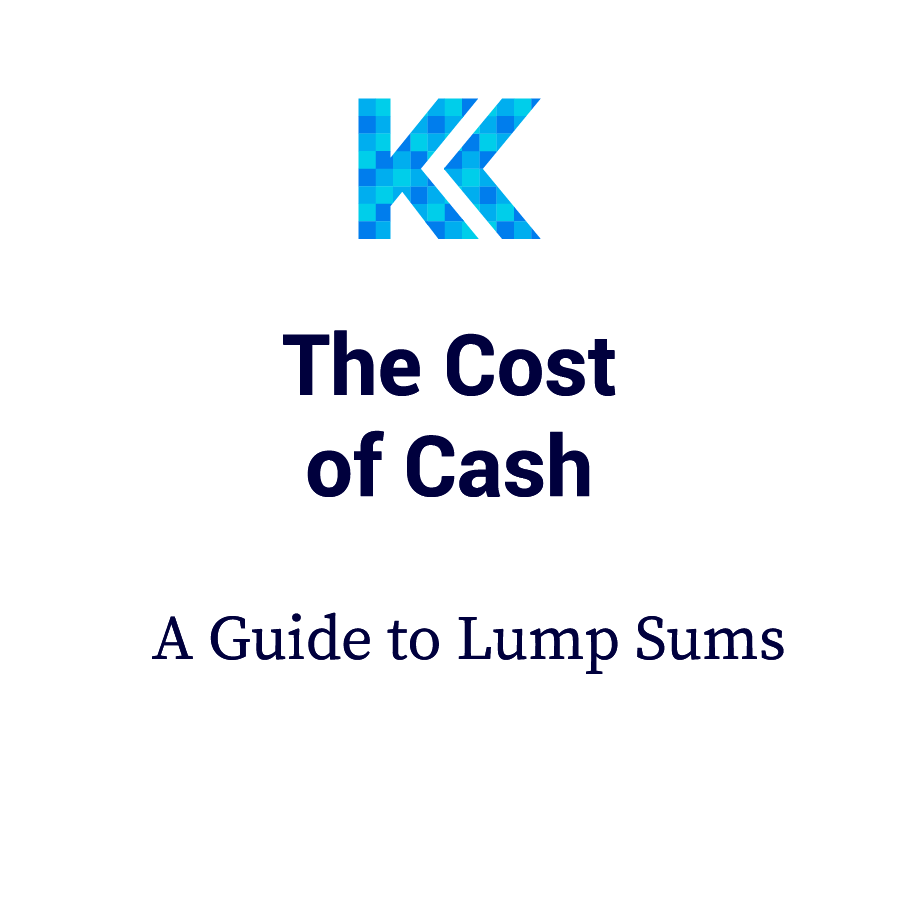Every year I meet people who receive a lump sum of cash. Sometimes it’s from selling a business, sometimes it’s an inheritance, and sometimes it’s just the result of years of disciplined saving. Almost every time, I hear the same hesitation: “I don’t want to put all of this into the market right away. What if it drops?”
That hesitation is natural, but it usually leads to one of two mistakes: leaving the money in cash for too long, or trying to “ease in” by investing small amounts over time. The problem is that neither of those strategies is actually the smartest thing to do with a lump sum.
The Hidden Cost of Cash
Cash feels safe because its value doesn’t bounce around day to day. But that stability is an illusion. Inflation slowly chips away at your purchasing power, and even with today’s higher savings account rates, most cash is not keeping up.
Here is how $1 invested from 1926-2025 would have grown if invested in each of the following assets:
Cash: $1
US Inflation (Reference): $18
US Long-Term Govt. Bonds: $128
US Large Stocks: $18,199
US Small Stocks: $39,224
If you have $500,000 sitting in the bank and inflation is running at 3 percent, you’ve effectively lost $15,000 of spending power in a single year. That’s the cost of waiting.
What the Numbers Say
Let’s look at a longer-term example.
Imagine you receive $1,000,000 and have two choices:
-
Investor A puts the entire amount to work right away in a diversified portfolio.
-
Investor B sits on the cash for three years, waiting for “the right time.”
Here’s what happens:
-
Year 1: Markets rise 8%
-
Year 2: Markets rise 18%
-
Year 3: Markets fall 15% (this is when Investor B finally invests)
-
Years 4–15: Markets average 9% annually over the next 12 years
Now let’s see where each investor ends up:
-
Investor A (invested immediately): After 15 years, the portfolio grows to about $3.36 million.
-
Investor B (waited three years): After missing the first two years of growth, sitting through a downturn in cash, and then finally investing, the portfolio grows to about $2.73 million.
That’s a difference of more than $600,000, all because of a three-year delay.
The takeaway is simple. Even though Investor B avoided the crash in the 3rd year, they permanently gave up the compounding benefits of those first two years of growth. The longer you let cash sit idle, the further behind you tend to fall.
What About Investing at All-Time Highs?
Another common hesitation I hear is: “I don’t want to invest right now because the market is at an all-time high.”
It’s an understandable concern, but the data tells a different story. Dimensional Fund Advisors looked at the S&P 500 (Large US Stocks) going all the way back to 1926. Roughly 31% of all months ended at a record high. In other words, the market is supposed to hit new highs regularly. That’s what long-term growth looks like.
And here’s what happened after those highs:
-
1 year later: Average annual return of about 13.7%, compared to 12.5% after any random month.
-
3 years later: Returns averaged 10.6%, essentially the same as the long-term average.
-
5 years later: Returns averaged 10.3%, again right in line with history.
The takeaway is clear: investing at a market peak has historically delivered returns very similar to investing at any other time. New highs are not a warning sign that you’re “too late.” They’re a natural part of a market that trends upward over time.
So whether you’re investing a lump sum today or building a long-term portfolio, don’t let headlines about all-time highs keep you sidelined.
Dollar-Cost Averaging vs. Lump Sum
Dollar-cost averaging (DCA) is the practice of spreading out investments over weeks or months. It can make people feel better because they don’t have to pick “the perfect day” to invest. But when researchers look at the data, lump-sum investing beats DCA roughly 66% of the time.
Why? Because markets tend to rise more often than they fall. By waiting, your money stays in cash, earning very little. Unless you happen to hit an unusually bad stretch of returns right at the start (which are impossible to accurately predict), you’re statistically better off getting invested right away.
Lump Sum Doesn’t Mean All Stocks
One of the biggest misconceptions I hear is that investing a lump sum means throwing everything into stocks on day one. That’s not the case.
The right way to think about lump-sum investing is this: you need to have a long-term, tax-efficient plan that determines a proper asset allocation for your money, then the best approach is to get to that mix immediately. That might mean a combination of large stocks, small stocks, bonds, and other alternative asset classes depending on your situation.
The key point is that once you’ve determined the allocation that matches your goals and risk capacity, there’s no mathematical advantage to sitting on cash.
The Emotional Hurdle
The real reason people delay investing isn’t math. It’s emotion. Nobody wants to be the person who invested right before a downturn. The fear of bad timing is powerful.
But here’s the reality: markets are unpredictable in the short run. There will never be a perfect moment to invest, and waiting for one is just another form of trying to time the market. Once you have a long term plan optimized for taxes & know your target allocation, the smartest thing you can do is implement it.
Common Questions
What if the market drops right after I invest?
That’s always possible. But history shows that markets recover, and the longer your time horizon, the less impact a short-term drop will have. What really hurts is missing the recovery because you stayed in cash.
Should I at least DCA for peace of mind?
Sometimes peace of mind has value. If putting it all in at once keeps you awake at night, spreading it out can be a behavioral compromise. But from a purely mathematical perspective, lump sum is the stronger choice.
Does this apply to every asset class?
Yes. The principle is not “put everything in stocks immediately,” it’s “get to your long-term allocation immediately.” That might be a mix of equities, bonds, or other investments, but the point is not to leave money idle.
Final Thoughts
If you’ve received a lump sum, the most important step is to decide what role that money plays in your long-term plan. Once that allocation is set, the math is clear: the sooner you put the money to work, the better.
Delaying feels safer, but it usually just means lower returns. Don’t let fear of short-term unknows rob you of long-term growth.
If you’re sitting on cash right now and want help building a plan that makes sense for your goals, this is a conversation worth having.

– Clint Kraft
Founder and Financial Advisor, Kraft Capital

